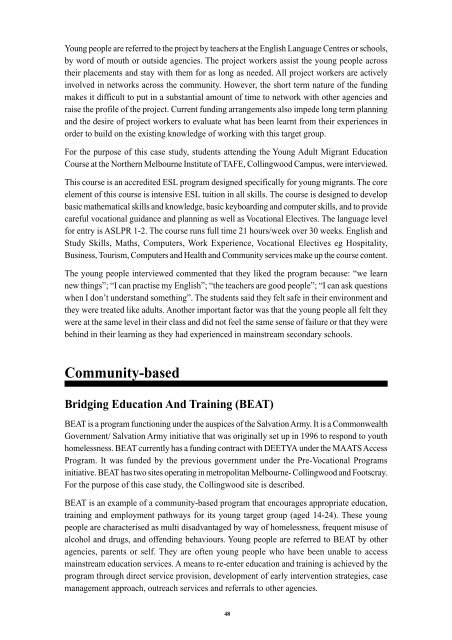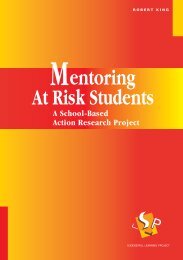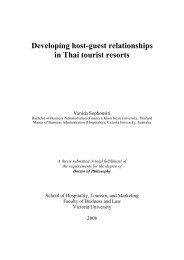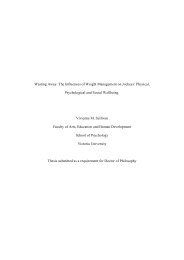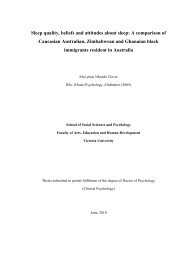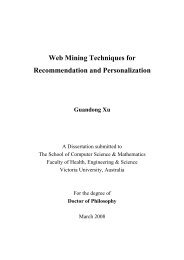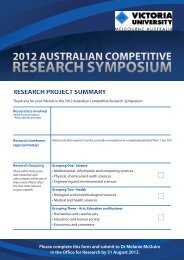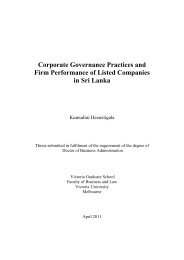Providing Education and Training for At Risk ... - Victoria University
Providing Education and Training for At Risk ... - Victoria University
Providing Education and Training for At Risk ... - Victoria University
- No tags were found...
You also want an ePaper? Increase the reach of your titles
YUMPU automatically turns print PDFs into web optimized ePapers that Google loves.
Young people are referred to the project by teachers at the English Language Centres or schools,by word of mouth or outside agencies. The project workers assist the young people acrosstheir placements <strong>and</strong> stay with them <strong>for</strong> as long as needed. All project workers are activelyinvolved in networks across the community. However, the short term nature of the fundingmakes it difficult to put in a substantial amount of time to network with other agencies <strong>and</strong>raise the profile of the project. Current funding arrangements also impede long term planning<strong>and</strong> the desire of project workers to evaluate what has been learnt from their experiences inorder to build on the existing knowledge of working with this target group.For the purpose of this case study, students attending the Young Adult Migrant <strong>Education</strong>Course at the Northern Melbourne Institute of TAFE, Collingwood Campus, were interviewed.This course is an accredited ESL program designed specifically <strong>for</strong> young migrants. The coreelement of this course is intensive ESL tuition in all skills. The course is designed to developbasic mathematical skills <strong>and</strong> knowledge, basic keyboarding <strong>and</strong> computer skills, <strong>and</strong> to providecareful vocational guidance <strong>and</strong> planning as well as Vocational Electives. The language level<strong>for</strong> entry is ASLPR 1-2. The course runs full time 21 hours/week over 30 weeks. English <strong>and</strong>Study Skills, Maths, Computers, Work Experience, Vocational Electives eg Hospitality,Business, Tourism, Computers <strong>and</strong> Health <strong>and</strong> Community services make up the course content.The young people interviewed commented that they liked the program because: “we learnnew things”; “I can practise my English”; “the teachers are good people”; “I can ask questionswhen I don’t underst<strong>and</strong> something”. The students said they felt safe in their environment <strong>and</strong>they were treated like adults. Another important factor was that the young people all felt theywere at the same level in their class <strong>and</strong> did not feel the same sense of failure or that they werebehind in their learning as they had experienced in mainstream secondary schools.Community-basedBridging <strong>Education</strong> And <strong>Training</strong> (BEAT)BEAT is a program functioning under the auspices of the Salvation Army. It is a CommonwealthGovernment/ Salvation Army initiative that was originally set up in 1996 to respond to youthhomelessness. BEAT currently has a funding contract with DEETYA under the MAATS AccessProgram. It was funded by the previous government under the Pre-Vocational Programsinitiative. BEAT has two sites operating in metropolitan Melbourne- Collingwood <strong>and</strong> Footscray.For the purpose of this case study, the Collingwood site is described.BEAT is an example of a community-based program that encourages appropriate education,training <strong>and</strong> employment pathways <strong>for</strong> its young target group (aged 14-24). These youngpeople are characterised as multi disadvantaged by way of homelessness, frequent misuse ofalcohol <strong>and</strong> drugs, <strong>and</strong> offending behaviours. Young people are referred to BEAT by otheragencies, parents or self. They are often young people who have been unable to accessmainstream education services. A means to re-enter education <strong>and</strong> training is achieved by theprogram through direct service provision, development of early intervention strategies, casemanagement approach, outreach services <strong>and</strong> referrals to other agencies.48


